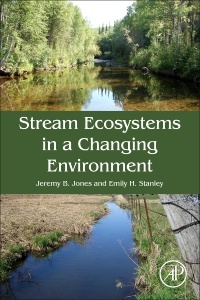Description
Stream Ecosystems in a Changing Environment
Coordinators: Jones Jeremy B., Stanley Emily
Language: English
Subject for Stream Ecosystems in a Changing Environment:
548 p. · 15x22.8 cm · Relié
Résumé
/li>Sommaire
/li>Lectorat
/li>Biographie
/li>Commentaire
/li>
Stream Ecosystems in a Changing Environment synthesizes the current understanding of stream ecosystem ecology, emphasizing nutrient cycling and carbon dynamics, and providing a forward-looking perspective regarding the response of stream ecosystems to environmental change. Each chapter includes a section focusing on anticipated and ongoing dynamics in stream ecosystems in a changing environment, along with hypotheses regarding controls on stream ecosystem functioning. The book, with its innovative sections, provides a bridge between papers published in peer-reviewed scientific journals and the findings of researchers in new areas of study.
Chapter 1: Hydrologic Exchange Flows and Their Ecological Consequences in River Corridors
Chapter 2: Shaping the Physical Template: Biological, Hydrological, and Geomorphic Connections in Stream Channels
Chapter 3: Stream Microbial Ecology in a Changing Environment
Chapter 4: Metabolism of Streams and Rivers: Estimation, Controls, and Application
Chapter 5: Nutrient Spiraling and Transport in Streams: The Importance of In-Stream Biological Processes to Nutrient Dynamics in Streams
Chapter 6: Dissolved Organic Matter in Stream Ecosystems: Forms, Functions, and Fluxes of Watershed Tea
Chapter 7: Stream-Lake Interaction: Understanding Coupled Hydro-Ecological Systems
Chapter 8: From Headwaters to Rivers to River Networks: Scaling in Stream Ecology
Chapter 9: Landscape and Regional Stream Ecology
Chapter 10: Global Models of River Biogeochemical Functioning
Chapter 11: Human Impacts on Stream Hydrology and Water Quality
Chapter 12: Human-Dominated Rivers and River Management in the Anthropocene
Chapter 13: Synthesis and Conclusions
Emily H. Stanley studies the dynamics of carbon, nitrogen, and phosphorous in streams and rivers and how these nutrients are affected by human activities. These research interests have led her to investigate the physical and ecological effects of degradation caused by development of land and water resources as well as the effects of stream restoration. Many of the recent activities with her students and collaborators have focused on issues of excess nitrogen in agricultural landscapes, and on the effects of dam removals and other restoration projects in Midwestern US watersheds. A central theme of much of this research is the interaction between ecology, geomorphology, and hydrology in aquatic environments.
- Presents a forward-looking perspective regarding the response of stream ecosystems to environmental change
- Provides a synthesis of the latest findings on stream ecosystems ecology in one concise volume
- Includes thought exercises and discussion activities throughout, providing valuable tools for learning
- Offers conceptual models and hypotheses to stimulate conversation and advance research




